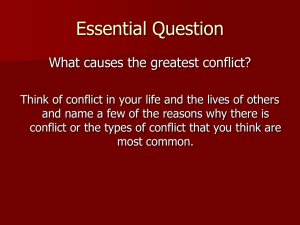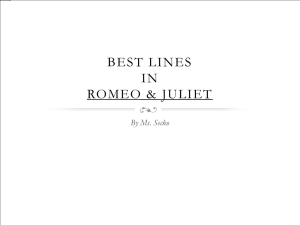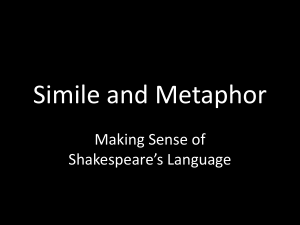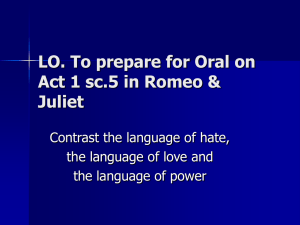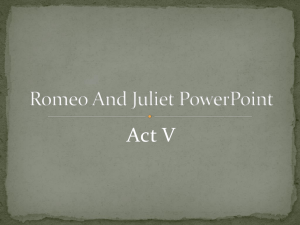Religious imagery in Act 1 scene 5
advertisement
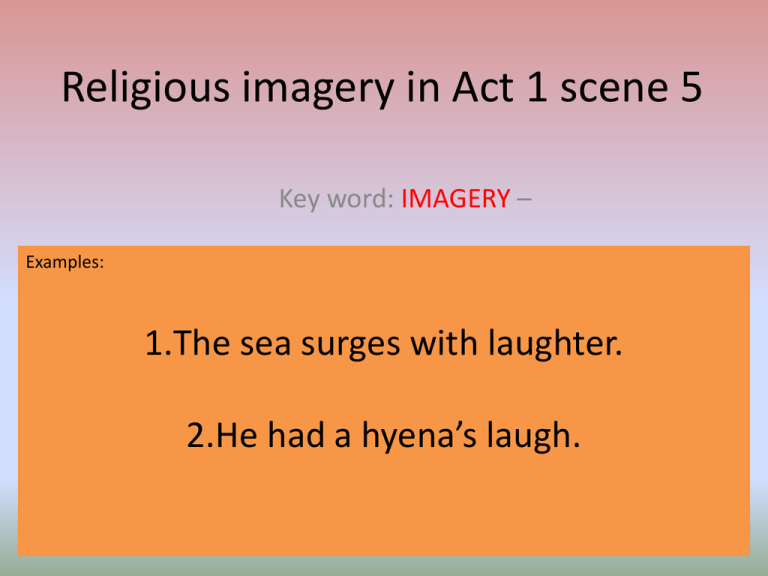
Religious imagery in Act 1 scene 5 Key word: IMAGERY – Examples: A technique writers use which help the reader to imagine a situation more clearly, involving or more of your fivelaughter. senses. 1.Theone sea surges with Often this includes powerful words (including 2.Heorhad a hyena’s laugh.etc) to similes metaphors, alliteration create images in a person’s mind. Learn the spellings and definitions for Friday 1. 2. 3. 4. 5. 6. 7. 8. 9. 10. Oxymoron Purged Feud Mutiny Fickle Pensive Imagery Hyperbolic Nought Couplet Ext: Quatrains Chaotic Melancholy Why are these sentences boring? 1. He had a big heart 2. She had beautiful eyes 3. Her face was pretty Connector – Fill in the missing words to create powerful imagery 3 mins 1. He has a heart as big as .... the outdoors 2. Her eyes sparkle like... a clear cut crystal 3. Her face is ... a blooming garden Objective, Big Picture and Outcome • To identify examples of religious imagery and to understand why it is used. • To do this you will: Watch a video, read and analyse a short extract, discuss ideas in groups, and draw key images. • By the end of the lesson you will have: Answered comprehension questions, drawn some images and explained why Shakespeare uses imagery. http://www.youtube.com/watch?v=74RXlBuQC_ g Here is Franco Zeffirelli’s 1968 version of Romeo and Juliet’s first meeting. Can you summarise what happens? Can you identify 5 examples of religious imagery in your copy of the Act 1, scene 5? pilgrims Palmers/ prayer holy Saints lips/ kiss Romeo and Juliet’s first words R If I profane with my unworthiest hand, This holy shrine, the gentle fine is this: My lips, two blushing pilgrims, ready stand To smooth that rough touch with a tender kiss. J Good pilgrim, you do wrong your hand too much, Which mannerly devotion shows in this; For saints have hands that pilgrims' hands do touch, And palm to palm is holy palmers' kiss. R Have not saints lips, and holy palmers too? J Ay, pilgrim, lips that they must use in prayer. R O, then, dear saint, let lips do what hands do; They pray, grant thou, lest faith turn to despair. J Saints do not move, though grant for prayers' sake. R Then move not, while my prayer's effect I take. Profane (am disrespectful) Unworthiest (undeserving) Pilgrims/ palmers (people come to pray) Mannerly devotion (normal prayer) What does Romeo want to do? If I profane with my unworthiest hand, This holy shrine, the gentle fine is this: My lips, two blushing pilgrims, ready stand To smooth that rough touch with a tender kiss. How does Juliet respond? Good pilgrim, you do wrong your hand too much, Which mannerly devotion shows in this; For saints have hands that pilgrims' hands do touch, And palm to palm is holy palmers' kiss. In what way is Romeo clever here? R Have not saints lips, and holy palmers too? J Ay, pilgrim, lips that they must use in prayer. R O, then, dear saint, let lips do what hands do; They pray, grant thou, lest faith turn to despair. J Saints do not move, though grant for prayers' sake. R Then move not, while my prayer's effect I take. To summarise... • Romeo thinks Juliet is the most beautiful creature he has ever laid his eyes on and he wants to get close to her. • He wants to kiss her so he uses the highest compliment to get her attention: he says she is a saint and he is a devoted Christian who has come to worship her. • Juliet is shy and tries to delay Romeo because, after all, she is a noble lady. • But Romeo is very clever and tricks her into kissing him. R If I profane with my unworthiest hand, This holy shrine, the gentle fine is this: My lips, two blushing pilgrims, ready stand To smooth that rough touch with a tender kiss. J Good pilgrim, you do wrong your hand too much, Which mannerly devotion shows in this; For saints have hands that pilgrims' hands do touch, And palm to palm is holy palmers' kiss. R Have not saints lips, and holy palmers too? J R J Ay, pilgrim, lips that they must use in prayer. O, then, dear saint, let lips do what hands do; They pray, grant thou, lest faith turn to despair. Saints do not move, though grant for prayers' sake. R Then move not, while my prayer's effect I take. Comment on the structure (AF4) 1. What do you notice about the rhyme scheme and lines? What is the narrative form? 2. There are three sets of four lines. What are these called? 3. What are the last two lines called? 4. What is the rhyme scheme? 5. Where else have you come across this rhyme pattern? 6. Why do the lovers speak in poetry? Individual task • Pick out three of the most powerful lines in this sonnet. Draw three images next to each to show your understanding. (5 mins) Why does Shakespeare use religious language here? (discuss in groups of 3) Consider • Shakespeare’s audience (16th century) and people’s religious views back then. • • Romeo’s motivation. Would Romeo have been able to woo (win over) Juliet just by going up to her? (Think about modern day chat up lines!) The purpose of imagery– why did we use imagery in the connector? 5 minutes before we share ideas. Review Turn to the person sitting next to you. • Tell them your definition of imagery in your own words include two examples from the play. • Now reflect on your discussion and complete this sentence : • Shakespeare uses religious imagery when Romeo and Juliet first meet because... Why use imagery? Romeo’s motivation Shakespeare’s Audience
